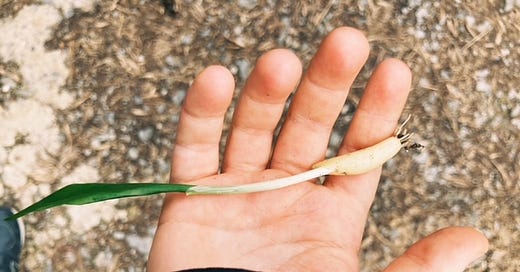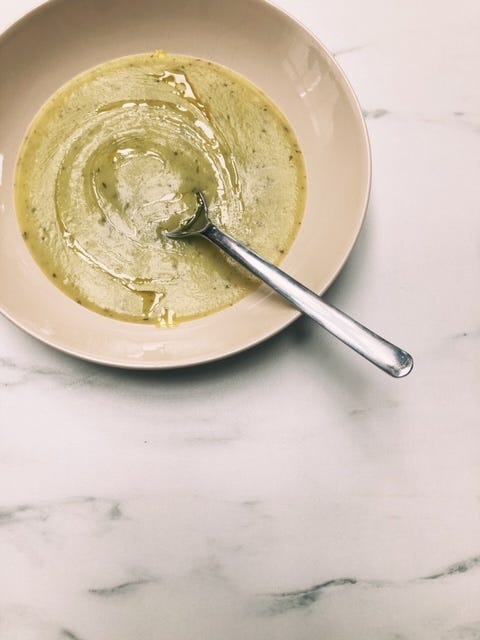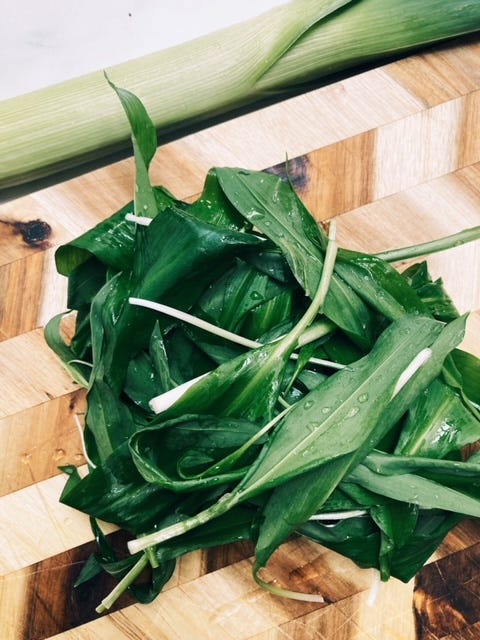It’s March and while Lazio has already experienced what might be considered summer weather here in Ireland, we continue to sport cozy sweaters as our days are still quite brisk. But all is well and good as our hemisphere begins to open up with the first signs of Spring where evenings are brighter, birds are singing, and flower buds are forming. I especially love the explosion of bright yellow daffodils and gorse that line the roads here in Kerry. It’s a sight that lifts the heart as the celebration of nature begins. While foraging is possible all year round, in this banquet we see the first signs of the our popular Edible and Medicinal Wild Plants. These non-domesticated plants that grow spontaneously in nature are some of the thousands of Edible and Medicinal Wild Plants on our planet.
When I think about foraging, I am brought back to a Spring morning in Rieti where we passed a hill dotted with more than a handful of women of a certain age, hunched over with heaving plastic bags in one hand and kitchen knives in the other. Their round skirt covered bums blowing in the wind were rising curtains for a show that involved the gathering of cicoria selvatica, or wild chicory. I still find the thought of this image to be so very amusing, as I could not understand what they could have possibly been up to at the time!
It was in the space of rural Italy, the most biodiverse country in Europe, where I first gained an appreciation for the Edible and Medicinal Wild Plants which are laced through every element of regional gastronomic culture as they flirt on the plates of Italian alta cucina and fortify the recipes that belong to the cucina povera. Then, it was an Irish rural life that guided me into a deeper interest and understanding of this world.
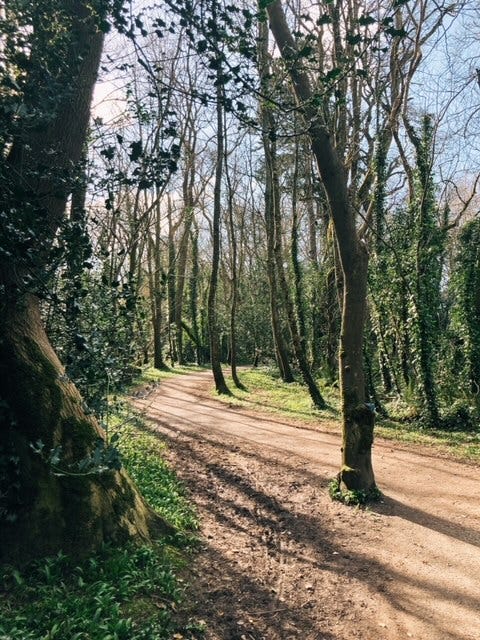
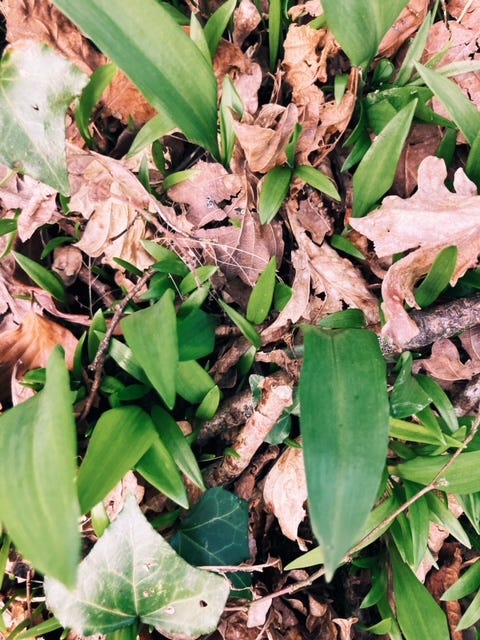
This past week the smallies skipped school to attend their routine dentist appointments and so with the afternoon free, we wandered into Ballyseedy Woods on the outskirts of Tralee for a bit of enchanted forest bathing with the main goal of gathering the Wild Garlic Ramsons or Allium Ursinum that have broken through the shady wet ground.
Wild Garlic boasts a long season, but March and April are when it’s at its best. Wild Garlic’s antiviral and antibacterial properties form part of its nutritionally generous profile, so the hope for some relief from a persistent sore throat was the main motivation for our wander through Nature’s Pharmacy. The other reason was this humble yet very satisfying soup.
While all parts of this plant are edible, with a flavour that is milder than domesticated garlic, it is also used in a similar way in recipes for butter, bread, pesto, salads, stews, sauces and side dishes.
The integration of Edible and Medicinal Wild Plants into my cooking to add some interest to run-of-the-mill recipes has become more purposeful since I have become more aware of the free nutritious food that grows wildly in both our rural and urban landscapes. The evolution of my own awareness is thanks to the major cultural shift, awakening and information sharing that is now happening in society to re-embrace a “knowing” that is written in our DNA from a time where wild plants were our primary food source. According to National Geographic, anthropologists have discovered evidence for the practice of hunter-gatherer culture by modern humans (Homo sapiens) and their distant ancestors dating as far back as two million years. Food as medicine dates back to ancient Rome and Greece where Hippocrates described the uses of over 300 medicinal plants, a sentiment that continues reverberate through modern Italian food culture.
Individuals and communities who have strayed from these practices since the introduction of industrial food, are now becoming aware of the nutrients and health properties embodied in these plants. It is through the study of Ethnobotany that we are able to rediscover and preserve these aspects of the local cultural heritage of our territories. Today Edible and Medicinal Wild Plants are being recognised as a valuable biological resource by both science and industry for their important role in a healthy diet as an alternative source of minerals, vitamins, antioxidants and essential oils. Government agencies are writing these same plants into new food strategies as a way to manage malnutrition problems and to diversify the human diet particularly in local food systems.
Both Italy and Ireland face a similar challenge when it comes to the global understanding of their true authentic cuisine. Between Chicken Parmesan and Corned Beef and Cabbage, it is difficult to imagine that Italian and Irish cuisine have anything in common, but strangely enough, parallels do exist. The beginning of this evidence can be found in the historic use of Edible and Medical Wild Plants with more to be found in this simple bowl of Leek, Potato and Wild Garlic Soup or vellutata di patate, porro e aglio orsino. In Ireland soup is just soup, but in Italy soup is broken down into seven different categories based on their specific characteristics. According to La Cucina Italiana, la vellutata consists of “2, maximum 3, types of vegetables as in the traditional combinations of potatoes-leeks, courgettes-potatoes, carrots-potatoes.”
I am not a wild food or foraging expert, it is only a personal hobby of mine, and therefore I am very much a student who is keen to learn as much as I can about this vast world with both commonalities and differences in terms of what can be foraged between Italy and Ireland. This also holds true for how I see myself in the kitchen – forever a student. So here I aim to share some thoughts around what I do know with the hope that it might spark your interest in Edible and Medicinal Wild Food if you are not already there. With this in mind, I do urge you to seek out reliable guide books and courses when it comes to foraging if you do not already possess this knowledge. Please be sure to study the characteristics, dangers and potential allergies associated with each plant that you may consider collecting. For example, in Ireland, Wild Garlic grows close to a poisonous plant called Lords-and-ladies which is highly toxic and its consumption can be fatal. This is only one example. The considered collection of mature Wild Garlic leaves would be advised so that young shoots are not confused with other plants.
I recommend this responsible foraging guide as a link to add to your collection.
Now the soup.
Potato, Leek and Wild Garlic Soup
Vellutata di porro, patate e aglio orsino
Serves 4-6
Ingredients:
1kg white boiling potatoes, peeled + cut into large even pieces
1 fat leek, sliced
40-50g wild garlic
1 vegetable stock cube of high quality
Extra virgin olive oil
Sea salt + black pepper
Method:
Coat the bottom of a medium, heavy bottomed pot, with a thin film of olive oil. Warm over medium-low heat and add your leek. Season and gently cook stirring until it is clear. Add the potatoes, wild garlic and stock cube. Add enough water to cover the potatoes. Season again, cover ¾ of the pan, bring to a boil and then simmer over low heat until the potatoes are tender. Purée with a hand blender and add a bit of boiling water if necessary to reach your desired consistency. Test the seasoning before serving and plate with a drizzle of olive oil.
*Notes: Young Nettle and Three-Cornered Leek/Garlic in similar amounts to the Wild Garlic in the recipe above also make for a nice addition to this Leek and Potato soup. Make sure to throughly wash and examine every leaf before use.


